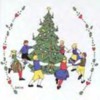In the Northern Hemisphere, the Winter Solstice occurs around December 21st, when the Sun is at its greatest distance below the celestial equator. The Vernal Equinox occurs around March 21st when the sun crosses the celestial equator and days have the same duration as nights ("equinox" comes from a Latin word meaning "time of equal days and nights"). The Vernal Equinox marks the beginning of Spring. The constellation (Zodiac sign) visible at dawn on the day of the Vernal Equinox has been regarded as of special significance (currently changing from Pisces to Aquarius due to the 26,000 year precession of the Earth -- the advent of "the Age of Aquarius").
The chief holiday for the ancient Hebrews was celebrated at the first full moon after the Vernal Equinox. Although this holiday was originally a celebration of Spring, it was later celebrated in remembrance of the Exodus from Egypt and was called Passover. The holiday entered Christian celebration by the fact that Christ was reputedly arrested and crucified at Passover. Because Christians insisted that Easter should be celebrated on a Sunday, the Council of Nicea decreed that Easter be the first Sunday after the fourteenth day of the moon (which is approximately the full moon) following the date of the Vernal Equinox (which is assumed to be March 21st). In the first centuries of Christianity Easter was by far the most significant Christian holiday and Christmas was not a holiday at all.
The word for "Easter" in most of the Romance Languages is a variant of the Hebrew "Passover", but the English word is unrelated to these forms. Possibly, the English word "Easter" is derived from the name of an Anglo-Saxon goddess of Spring, "Eostre". Or it may have come from "Ishtar/Astarte" the Babylonian/Chaldean Venus who was the consort of the sun-god. Sunrise service, painted eggs and rabbits have all symbolized rebirth and fertility in Spring celebrations from ancient times. Celebration of motherhood (mother's day) is also most often in the Spring, another possible association with fertility.
...
Osiris then dwelled in the underworld as the king & judge of the dead. Isis nonetheless gave birth to the divine child "Horus the younger" (presumably a virgin birth). In fourth-century Alexandria, "Madonna" could have been a reference to the mother goddess Isis or Saint Mary. The last Egyptian Temple of Isis was converted to a Christian Church in the sixth century AD.
...
Stars had signalled the birth of Krishna, Lao-Tze, Moses and Abraham. Several attempts have been made to give explanations for the Star of Bethlehem. In the 14th century Albert Magnus (teacher of Thomas Aquinas) noted that the constellation Virgo rose above the horizon at midnight on December 24th at the reputed time of Christ's birth.
...
In 270 AD a professional army officer named Aurelian rose to be emperor and was able to reunite the Roman Empire through military might. In 274 AD he attempted to unit the religions of the empire under the state cult of Sol invictus ("unconquerable Sun"). Aurelian's new temple enshrined the Sun gods of Babylonia (Baal, Bel or Marduk). Although Mithras was not formally acknowledged, Natalis solis invicti ("birth of the unconquered sun") was, nonetheless, on December 25th.
...
The Japanese celebrate oseibo, a gift-giving season that is coincidentally in December.
...
In the 1960s an activist California professor of Black Studies created the holiday of Kwanzaa in reaction against Christmas as an institution of commericialism & exploitation not relevant to African-Americans. The word "Kwanzaa" comes from a phrase meaning "first fruits" in Swahili, the most widely spoken African language. In the seven days from December 26th to January 1st the seven communitarian African values are strengthened & celebrated: Unity, Self-determination, Collective Work and Responsibility, Cooperative Economics, Purpose, Creativity and Faith.
http://www.siriustechgroup.com/about.html

Sirius is the name of the principal star in the constellation Canis Major. It's also the brightest star in the heavens and is only 8.6 light years from earth, making it one of the closest stars in our stellar neighborhood. It is visible in the Northern Hemisphere from December to March, and visible in the Southern Hemisphere between November and April. If you want to see Sirius for yourself, look up at the night sky towards the south. If you know the constellation "Orion the Hunter," locate his belt. Follow along his belt line off towards the left and you'll see a very bright star, that's Sirius. We named ourselves after the star because we believe that Sirius Technology Group is the "brightest star" when it comes to providing quality software for the automotive industry.
http://www.robertbauval.com/articles/article3.html
The celestial imagery, therefore, is that on the 25th December, right after sunset, the three stars of Orion's belt were seen rising in the east as if to 'herald' the coming of the birth-star Sirius, which followed about one hour after. It would be very unlikely that such a powerful celestial sign which was known to denote the 'birth of the divine child' in Egypt since time immemorial would not have been unnoticed by the writer of the 'Matthew' Gospel. It seems evident that the introduction of a new divine child (Jesus) born from the Madonna (Mary) in Egypt and the Graeco-Roman world would benefit greatly by absorbing the older and very powerful mythology of Isis and her star, Sirius.

Plate 11: Madonna and Child (Leonardo Da Vinci)
Thus Isis and the child Horus were metamorphosed into the Madonna and child Jesus, and the star Sirius became the 'Star of the East' which the wise men saw and heralded the birth of Jesus. Much later, three wise men became known as the 'three kings' in Western tradition and, in keeping with stellar symbolism, they also became identified to the three stars of Orion's belt.
http://www.enterprisemission.com/millenn3.htm
The most crucial determination made by the Nicene council was that the Spring Equinox fell on the date of March the 21st, thereby setting Easter from this date.
Things stayed pretty much the same until 527 AD, when Dionysius Exiguus instituted the so-called "Christian Era." He overturned the Julian practice of dating back to 4713 BC, and established the BC and AD dating system. In doing so, he established a date for both the incarnation and birth of Christ (March 25th, and December 25th respectively. December 26th is the birthday of Osiris). From that time on, all dates would be marked from the year of Christ's birth, and the turn of the 3rd Millennium was then set at January 1, 2000 AD.
http://www.christianmyth.com/Jesus05.htm

Out of all of the places on the Eastern horizon for the sun to rise on December 25th, it rises directly below the star Sirius (a.k.a. - The Star of Bethlehem).
http://jesusastrotheology.netfirms.com/virgo_virgin_gave_birth_son_sun.htm
December 21st of each year the Sun reaches its lowest point of declination at the Tropic of Capricorn. It then remains, seemingly motionless (Sol, the Sun, "stands still" Sol-stice) the 22nd, 23rd and 24th, and then on the 25th of December (Christmas) it has noticeably started its return North toward the Equator and therefore is "born again".








